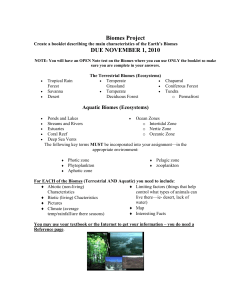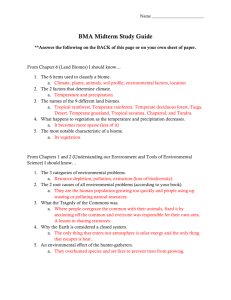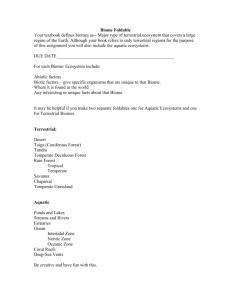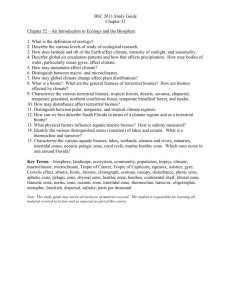Terrestrial Biomes - Discovery Education
advertisement
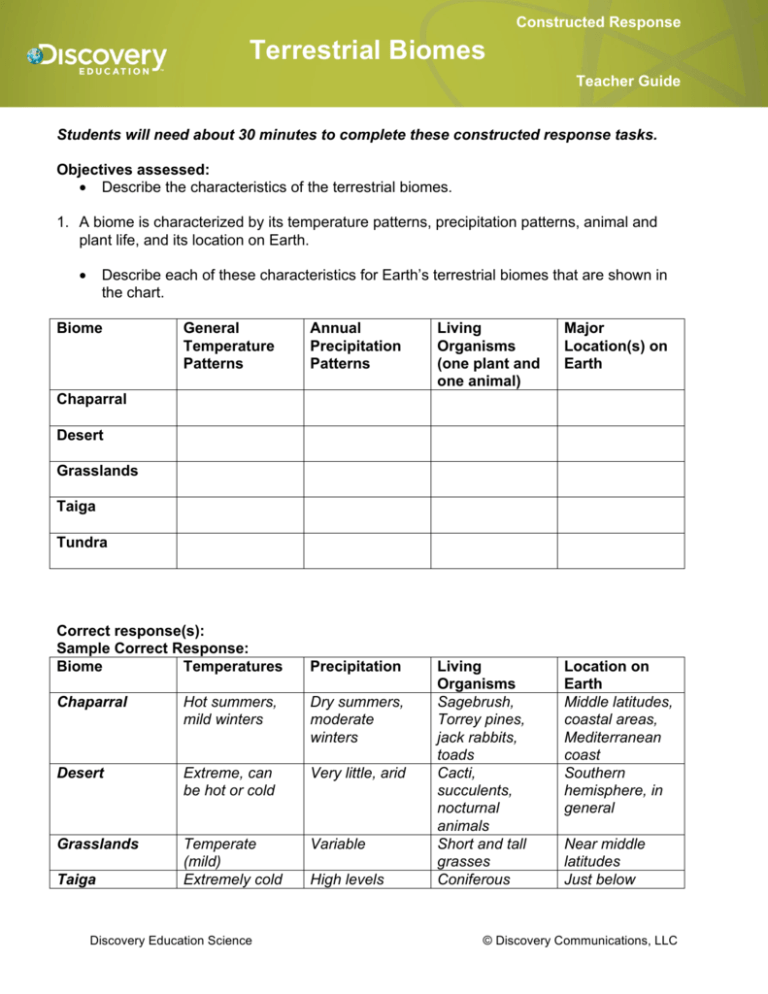
Constructed Response Terrestrial Biomes Terrestrial Biomes Teacher Guide Students will need about 30 minutes to complete these constructed response tasks. Objectives assessed: • Describe the characteristics of the terrestrial biomes. 1. A biome is characterized by its temperature patterns, precipitation patterns, animal and plant life, and its location on Earth. • Describe each of these characteristics for Earth’s terrestrial biomes that are shown in the chart. Biome General Temperature Patterns Annual Precipitation Patterns Living Organisms (one plant and one animal) Major Location(s) on Earth Precipitation Living Organisms Sagebrush, Torrey pines, jack rabbits, toads Cacti, succulents, nocturnal animals Short and tall grasses Coniferous Location on Earth Middle latitudes, coastal areas, Mediterranean coast Southern hemisphere, in general Chaparral Desert Grasslands Taiga Tundra Correct response(s): Sample Correct Response: Biome Temperatures Chaparral Hot summers, mild winters Dry summers, moderate winters Desert Extreme, can be hot or cold Very little, arid Grasslands Temperate (mild) Extremely cold Variable Taiga Discovery Education Science High levels Near middle latitudes Just below © Discovery Communications, LLC Terrestrial Biomes winters, warm summers Tundra Extremely cold and windy Dry forests, squirrels, moose, bobcats Low growing plants, caribou, polar bears Arctic circle Northernmost latitudes Response scoring tool: Score 5 4 3 2 1 0 Content Correctly describes the main characteristics of the five terrestrial biomes. Correctly describes the main characteristics of four terrestrial biomes. Correctly describes the main characteristics of three terrestrial biomes. Correctly describes the main characteristics of two terrestrial biomes. Correctly describes the main characteristics of one terrestrial biome. No response, or response not appropriate to the question. Objectives assessed: • Describe the characteristics of the terrestrial biomes. 2. Three main forest biomes exist on Earth: tropical rain forest, temperate rain forest, and temperate deciduous forest. • Compare the average annual temperatures, average annual precipitation, and general locations of each forest biome. Correct response(s): Sample Correct Response: The tropical rain forest biome is hot and humid all year, whereas the other forest biomes have seasonal variations in temperature. The temperate deciduous forest receives about 75–150 cm of rainfall per year. The temperate rain forest receives high amounts of annual rainfall, with some areas receiving up to 300 cm per year. The tropical rain forest receives the most annual rainfall at approximately 300 cm per year. Tropical rain forest biomes are located near the equator. Temperate rain forests are located near the equator and along coastal areas. Temperate deciduous forests are located along the mid-latitudes. Objectives assessed: • Compare variations of organisms living in different ecosystems Discovery Education Science © Discovery Communications, LLC Terrestrial Biomes 3. When comparing organisms in different ecosystems, great differences can often be found. This is because different ecosystems present different selection pressures on the organisms creating the need for different traits. What is an ecosystem and describe it in relation to a biome? Compare and explain the variations and organisms living in two different ecosystems. Correct response(s): Sample Correct Response: An ecosystem describes the interactions that take place between animals, plants, soil, and other living organisms within a specific area. Biomes contain multiple ecosystems. Living in the Arctic, animals and plants need to be well adapted for cold, dry weather. The top predator in the Arctic, the polar bear, has, below its white fur, black skin to absorb as much heat from the sun as it can. Its fur is clear, but reflects the light coming off the snow, so it appears white. This camouflages it while it is hunting prey. Polar bears also have very wide feet that act like snowshoes. These prevent the bear from falling into the snow as it is walking around hunting for prey. Other organisms, such as the snowshoe hare have the same adaptation Whales are also well adapted to the cold. They have a very thick layer of blubber that acts as insulation as they are moving through the frigid waters of the north. Plants are also well adapted to this region. Since there is very little rain, the leaves of many trees have been modified into thin needles. This reduced surface area prevents water loss. Many smaller plants are dormant in the cold winter months. Compared to living in the Arctic, animals and plants living in the hot desert have adaptations that have evolved to cope with the hot, arid climate. Plants often have small spiky leaves to reduce transpiration and protect from predators. Many plants store water. Cacti store water in their stems but other desert plants have underground tubers that act as storage organs for water and food. Others drop their leaves or die back in the driest part of the year. Many desert animals protect themselves from the hot desert sun by seeking out shade during the hottest part of the day. Many live in burrows and come out only in the cool of the night. Desert animals often have special cooling mechanisms. For example the big ears of the bateared fox act as radiators. Many desert animals can go without drinking, obtaining their water entirely from food. Response scoring tool: Score 5 Content A score of 5 indicates complete understanding of the definition of an ecosystem and relation to biomes, and of the two compared ecosystems and the traits animals and plants have developed to live there. There is discussion of several different organisms and the adapted traits for the Discovery Education Science © Discovery Communications, LLC Terrestrial Biomes 4 3 2 1 0 biomes. A score of 4 indicates understanding of the definition of an ecosystem and relation to biomes, and of the different ecosystems and the adaptations organisms have to live there. While some traits are present, not all are discussed. A score of 3 shows understanding of the definition of an ecosystem and relation to biomes, and that organisms have evolved traits to live in the ecosystems they do, but there is no connection between those traits and why they work for survival. A score of 2 shows recognition of different ecosystems, but minimal connections with any traits or mention of biomes. Few, if any traits are discussed. A score of 1 indicates minimal understanding of what an ecosystem is and its relation to biomes, and there is no discussion of any traits or the functions of those traits. No response, or response not appropriate to the question. Discovery Education Science © Discovery Communications, LLC

